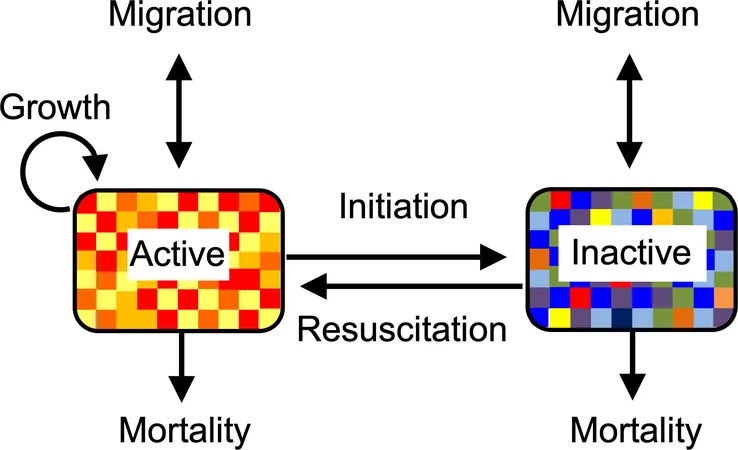
Dormancy: The Hidden Key to Life's Survival on Early Earth?
2025-01-08
Author: Emma
The Extreme Early Earth Environment
The early stages of our planet Earth were nothing short of extreme, with a harsh landscape bombarded by asteroids, erupting volcanoes spewing deadly gases, and a thick, toxic atmosphere devoid of oxygen. It was against this inhospitable backdrop that life first emerged—a mystery that has left scientists pondering how life not only began but managed to persevere through such cataclysmic conditions.
The Concept of Dormancy
Recent research published in the Proceedings of the Royal Society B: Biological Sciences highlights a fascinating concept: dormancy. This phenomenon may have been a critical strategy for life’s chemical precursors, enabling them to withstand the intense challenges posed by early Earth. Kevin Webster, an associate research scientist at the Planetary Science Institute, and his collaborator Jay Lennon from Indiana University delve into this intriguing hypothesis.
Dormancy as a Survival Strategy
According to Webster, the concept of dormancy might be older than life itself. He explains, "We were discussing whether dormancy could have existed before life, and I believe it most certainly could. This conversation sparked our research." Dormancy allows organisms to minimize their risk of extinction in unfavorable conditions by entering a dormant state, where they can resist environmental stressors and 'wake up' when conditions improve.
Examples from Nature
Imagine a time when rivers were drying up; if a creature was active and didn’t find food, its fate would be sealed. In contrast, those organisms that could enter dormancy would survive to thrive another day when environmental conditions became favorable again. "Dormancy creates a 'seed bank'—a reservoir of genetic diversity that ensures life doesn’t have to restart from scratch repeatedly during tumultuous periods," Webster notes.
Dormancy in Early Life
The research suggests that even the earliest chemical precursors of life showed signs of dormancy—exhibiting adaptable traits that allowed them to switch between active and dormant states based on environmental cues. For instance, DNA is an essential molecule that encapsulates genetic information. Its dual strands can separate under high temperatures and recombine when it cools, showcasing a primitive form of dormancy. Furthermore, DNA can wrap around proteins, protecting its integrity until the right conditions for replication arise.
The Implications of Dormancy
By studying the tree of life and the fossil record, Webster and Lennon emphasize that dormancy has played a ubiquitous role across various organisms throughout Earth's history, including today. This resilience not only helps mitigate extinction risks but shapes the distribution of life across the planet. Depending on its origins—be it an isolated hot spring or the expansive ocean—dormancy could have significantly influenced the dispersal of early life forms.
Looking Forward
Understanding the role of dormancy provides insight into how life originated, spread, and thrived on Earth and may even have implications for the search for extraterrestrial life. "How does life evolve from simple non-living molecules to living entities? Exploring this transition could inform our quest for life on other planets," states Webster. This knowledge could illuminate not just the conditions necessary for life to arise, but also guide scientists in their search for similar signs of life beyond Earth.
Conclusion
As research continues, the story of dormancy could reshape our understanding of life's origins and its enduring resilience against the odds. What other secrets lie in the depths of our planet's history? Stay tuned as scientists unravel the complexities of life's first survival strategies!



 Brasil (PT)
Brasil (PT)
 Canada (EN)
Canada (EN)
 Chile (ES)
Chile (ES)
 Česko (CS)
Česko (CS)
 대한민국 (KO)
대한민국 (KO)
 España (ES)
España (ES)
 France (FR)
France (FR)
 Hong Kong (EN)
Hong Kong (EN)
 Italia (IT)
Italia (IT)
 日本 (JA)
日本 (JA)
 Magyarország (HU)
Magyarország (HU)
 Norge (NO)
Norge (NO)
 Polska (PL)
Polska (PL)
 Schweiz (DE)
Schweiz (DE)
 Singapore (EN)
Singapore (EN)
 Sverige (SV)
Sverige (SV)
 Suomi (FI)
Suomi (FI)
 Türkiye (TR)
Türkiye (TR)
 الإمارات العربية المتحدة (AR)
الإمارات العربية المتحدة (AR)